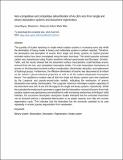| dc.contributor.author | Bayuo, Jonas | |
| dc.contributor.author | Rwiza, Mwemezi | |
| dc.contributor.author | Mtei, Kelvin | |
| dc.date.accessioned | 2023-03-22T06:53:02Z | |
| dc.date.available | 2023-03-22T06:53:02Z | |
| dc.date.issued | 2023-01-14 | |
| dc.identifier.uri | https://doi.org/10.1007/s13399-022-03734-0 | |
| dc.identifier.uri | https://dspace.nm-aist.ac.tz/handle/20.500.12479/1836 | |
| dc.description | This research article was published by Springer Nature Switzerland AG. in 2023 | en_US |
| dc.description.abstract | The quantity of studies reporting on single-metal sorption systems is increasing every day while the elimination of heavy metals in binary and multisolute systems is seldom reported. Therefore, the biosorption and desorption of arsenic from single and binary systems on hybrid granular activated carbon have been investigated using the batch technique. The hybrid granular activated carbon was characterized using Fourier transform infrared spectrometer and Brunauer–Emmett–Teller, and the results showed that the biosorbent surface characteristics could facilitate arsenic removal from the non- and competitive biosorption media. The main biosorption mechanisms of arsenic on the biosorbent involved surface complexation, electrostatic attraction, and replacement of hydroxyl groups. Furthermore, the effective elimination of arsenic was discovered to be reliant on the sorbent’s physicochemical properties as well as all the studied independent biosorption factors. The equilibrium sorption data of both the single and binary systems were best explained by the Langmuir and pseudo-second-order models, indicating the mechanism of arsenic biosorption was mainly chemisorption. The Langmuir maximum monolayer sorption capacities of the biosorbent were 205.76 and 153.09 mg/g for the single and binary systems, respectively. While the evaluated thermodynamic parameters suggest that the biosorption removal of arsenic from both sorption systems was spontaneous and endothermic with increasing randomness at the liquid–solid interface, the successive biosorption–desorption studies indicated that the exhausted biosorbent can be renewed without a substantial deterioration in its uptake capacity even after the seventh regeneration cycle. This indicates that the biosorbent has the economic potential to be used repeatedly in arsenic species sequestration from wastewater. | en_US |
| dc.language.iso | en | en_US |
| dc.publisher | Springer Nature Switzerland AG. | en_US |
| dc.subject | Binary system | en_US |
| dc.subject | Biosorption | en_US |
| dc.subject | Desorption | en_US |
| dc.subject | Regeneration | en_US |
| dc.subject | Single system | en_US |
| dc.title | Non-competitive and competitive detoxification of As (III) ions from single and binary biosorption systems and biosorbent regeneration | en_US |
| dc.type | Article | en_US |

